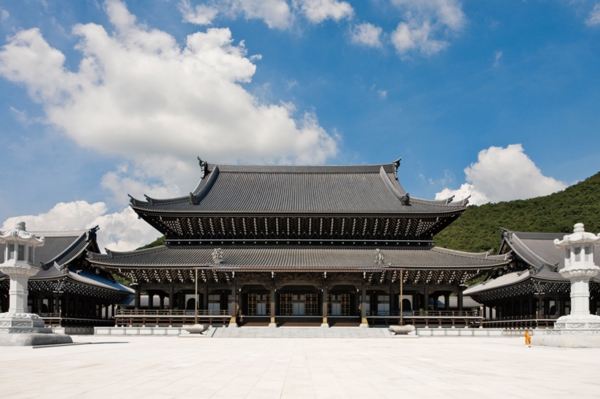The Royal Grand Hall of Buddhism,
the Head Temple of Nenbutsushu Sampozan Muryojuji Temple
The Main Hall

The upper part of the hall has six-stepped intermediate bracket complexes, the first of its kind in the history of Japanese architecture, and the lower part has four-stepped intermediate bracket complexes, both incorporating fan rafters. It is 51.5 meters high, comparable to an 18-story building. There are used as many as 124,000 of the biggest roof tiles in the world. The onigawaras, demon-faced ridge-end tiles, rising on the waves of roof tiles, are registered in the Guinness World Records. Their infuriated expression helps sentient beings to sweep away their desires and bring about pure and innocent minds.
In front of the hall, the largest Stone Lanterns in the world, which have been registered in the Guinness World Records, stand high on both sides, welcoming worshippers. They symbolize the Dharma torch that ceaselessly illuminates and guides sentient beings to the Buddhist way.
Under the eaves, among the upper multi-stepped intermediate bracket complexes, 80 sculptures of Sakyamuni Tathagata are attached, encouraging all sentient beings in all directions to save others. Adorned below are 88 carved dragons, and on the frog-leg struts among the lower multi-stepped intermediate bracket complexes, there are 104 carved dragons on the outside and 104 life-sized sculptures of flying celestial beings on the inside. Over 100,000 gold plates decorate the entire Main Hall brightly, manifesting the brilliance of the Pure Land.
Inside the hall, there stands the magnificent doubly-gilded Golden Shrine with six-stepped intermediate bracket complexes. The shrine houses the image of Amida Triad, the principal image of the temple, carved by Mr. She Guo Ping, a living national treasure of China. The image shines in brilliant gold as if the Buddha illuminates the world with sparkling light of compassion.
On both sides of the Golden Shrine, one can see the sculptures of the 25 bodhisattvas flying airily to follow Amida Buddha. They look as if they were guiding sentient beings to the Pure Land. The interior walls of the hall are covered with the extensive paintings on gilded screens. The colorful pictures of phoenixes and auspicious clouds as well as lotus flowers underneath painted by the master artist Mr. Masahiko Misaka are suggestive of the exquisite scenery of the Pure Land. It will take longer than one can possibly spend to appreciate all the works. Each work, harmonizing with others, praises the exquisite Pure Land. Every visitor will be struck with awe and feel reverence for the Buddha.
* This temple is not a tourist facility but a monastery to practice the original teachings of Lord Buddha.

 The Grand Bell Towers
The Grand Bell Towers